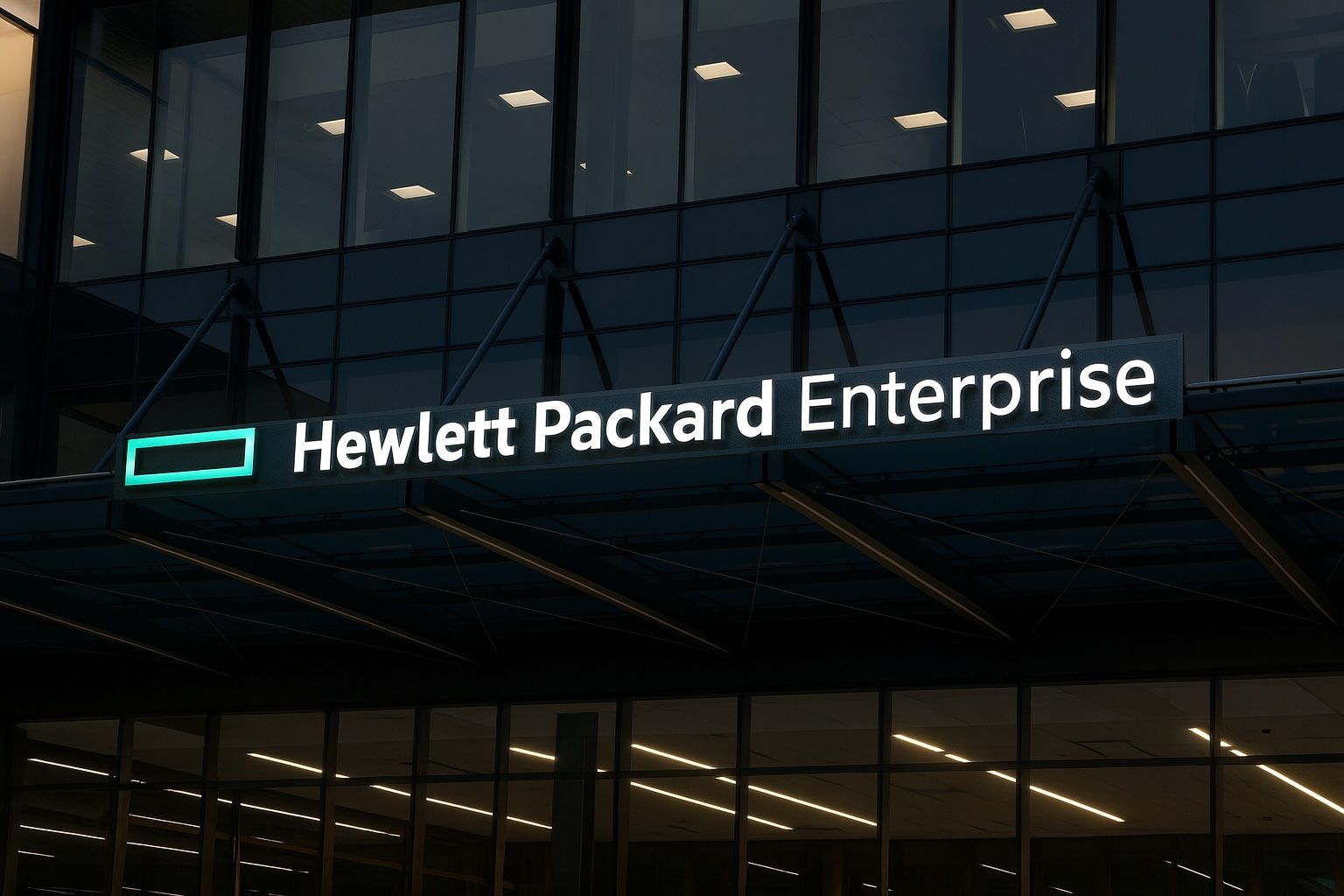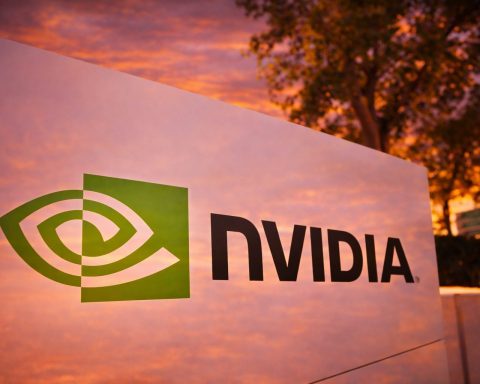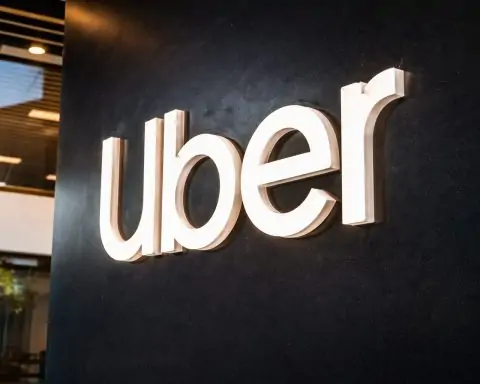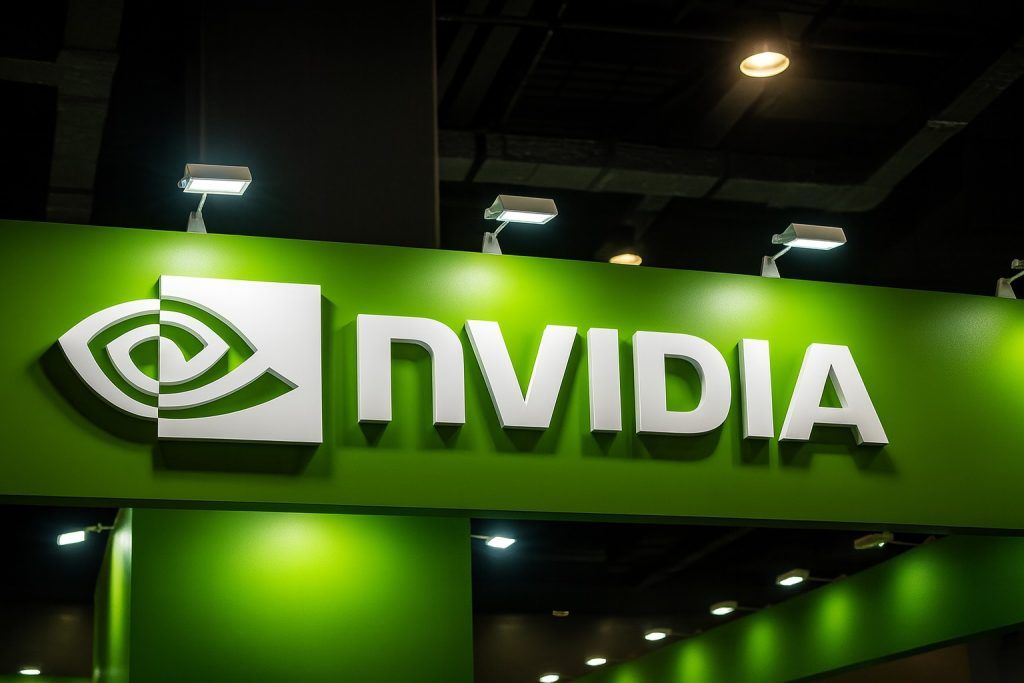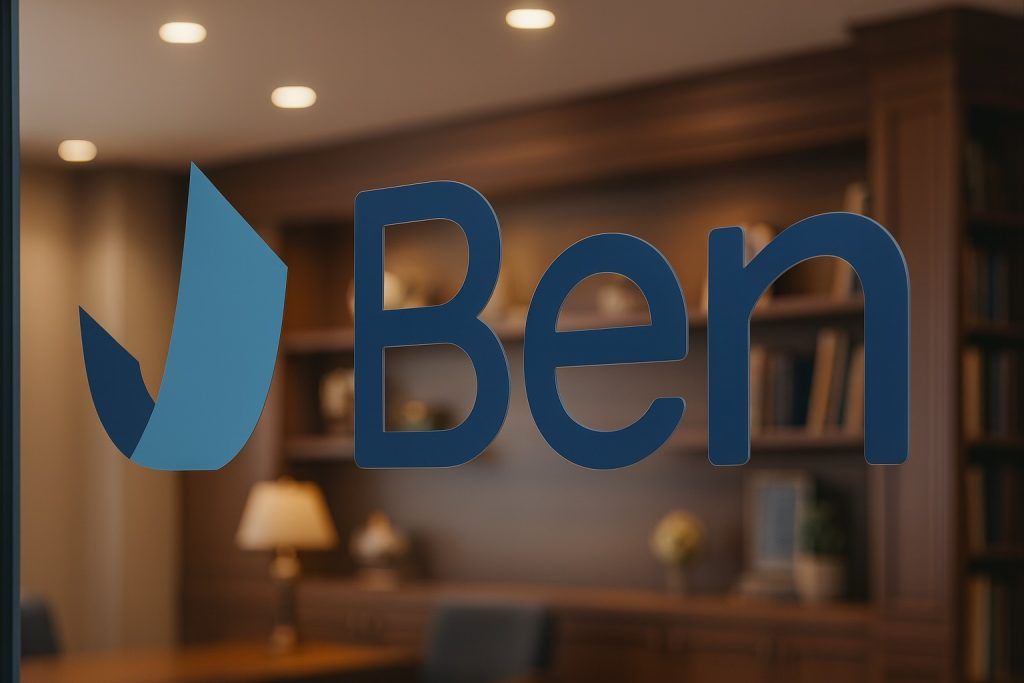- Stock Near Highs, Then Pullback: Hewlett Packard Enterprise (NYSE: HPE) stock is trading around the mid-$23 range as of October 22, 2025, after a turbulent week [1]. Shares hit a 52-week high of $26.44 earlier this month amid AI-fueled optimism, and remain up double-digits percentage-wise year-to-date [2] despite a recent dip.
- Guidance Shocks Wall Street: At an Oct. 15 analyst meeting, HPE issued cautious fiscal 2026 forecasts – projecting only 5–10% revenue growth and $2.20–$2.40 EPS, barely at the low end of consensus [3] [4]. This outlook “fell dramatically short” of bullish expectations (~17% growth) [5], triggering an after-hours sell-off with HPE stock plunging ~6% on the news [6]. Investors were startled that a company touting its AI and cloud prowess might grow only in the single digits, sparking concerns about execution [7].
- Shares Slump Then Rebound: Following the guidance bombshell, HPE shares dropped over 8% at one point – the steepest drop in six months [8] – reflecting a “reality check” on margins and growth in the AI era [9]. The stock fell from the mid-$26s to around $22.50 [10], but has since recovered to ~$23–$24 as investors digest the news. HPE’s market cap now sits near $33 billion [11], roughly unchanged on the week as some dip-buyers stepped in.
- Investor Rewards Announced: To bolster confidence, HPE unveiled shareholder-friendly moves. The company will raise its annual dividend by 10% for FY2026 and authorized an additional $3 billion share repurchase program (bringing total buybacks to ~$3.7B) [12] [13]. These moves signal management’s confidence in HPE’s cash flow and were cheered by income investors, even as near-term growth guidance disappointed.
- AI & Networking Deals in Focus: HPE is doubling down on next-gen networking and AI. Earlier in October, Nokia licensed HPE’s AI-powered RAN (radio access network) technology to enhance Nokia’s 5G/6G telecom automation platform [14] [15] – a partnership that briefly boosted HPE’s stock ~7% on optimism about its telecom influence. HPE also partnered with Ericsson to validate a dual-mode 5G core solution [16], underscoring its role in telecom infrastructure. These deals validate HPE’s tech prowess in AI-driven networking, even if they won’t radically move the revenue needle overnight [17].
- Strong AI-Fueled Quarter, But Mixed Results: In its latest quarter (Q3 FY2025), HPE’s revenue surged ~19% year-over-year to $9.14 billion, handily beating forecasts thanks to record sales of AI systems [18]. However, profitability lagged – quarterly EPS was just $0.35 vs $0.44 expected, and HPE trimmed its full-year outlook [19]. This mixed result (booming sales but weaker margins) foreshadowed the cautious forward guidance and kept some investors wary.
- Major Acquisition & Restructuring: HPE completed a $14 billion acquisition of Juniper Networks in mid-2025, a blockbuster deal aimed at doubling HPE’s networking business and closing the gap with rival Cisco [20]. The integration is underway: HPE will merge its server, cloud, and financial services units into a new “Cloud & AI” segment next year [21], and plans to cut some jobs (with ~$240M in restructuring costs) as it folds Juniper in [22]. Executives say Juniper’s portfolio will drive “more profitable growth” long-term [23], but in the near term HPE is balancing growth ambitions with cost synergy execution.
- Analyst & Investor Sentiment: Wall Street’s stance on HPE is cautious but not bearish. Most analysts rate HPE a “Hold” with an average 12-month price target around $25 – roughly where the stock trades now [24] [25]. The tempered FY2026 outlook was a “sobering reality check” that raised “serious questions” about HPE’s ability to capitalize on the AI boom [26]. Still, bulls note HPE’s stock is reasonably valued (~10× projected 2028 earnings) and offers a growing ~2% dividend yield [27] [28]. The long-term vision – targeting $3.5B+ free cash flow and $3.00+ EPS by FY2028 [29] [30] – suggests significant upside if HPE can deliver, with one analysis pegging fair value near $47 per share (almost double the current price) in a bullish scenario [31] [32].
HPE Stock Volatility: From Highs to a Post-Guidance Slump
Hewlett Packard Enterprise headquarters in Texas. The company’s stock has experienced volatility amid surging AI enthusiasm and cautious financial guidance.
After a steady climb through 2025, HPE’s stock rally hit turbulence in mid-October. The shares were hovering near multi-year highs above $26 just before the company’s annual Securities Analyst Meeting on Oct. 15 [33]. Optimism was running high – HPE had gained roughly 15–20% year-to-date on the back of strong demand for its AI infrastructure and cloud offerings [34]. In fact, the stock notched a 52-week high of $26.44 in early October amid broader tech euphoria [35]. Long-term shareholders were sitting on healthy gains; HPE returned ~24% over the past year and an impressive 211% over five years [36]. By mid-October, with the market near record highs, many assumed HPE’s ride upward would continue.
That sentiment quickly changed when HPE’s management delivered surprisingly muted guidance for the coming fiscal year. On Oct. 15, CEO Antonio Neri and his team outlined their outlook for FY2026 – and it was more conservative than expected. They projected revenue growth of just 5% to 10%, alongside adjusted earnings of $2.20–$2.40 per share [37] [38]. For context, analysts had been modeling closer to ~17% revenue growth next year, given HPE’s exposure to hot areas like AI and hybrid cloud [39]. The modest guidance “fell dramatically short” of those bullish forecasts [40]. Likewise, the EPS range’s midpoint (~$2.30) barely meets Wall Street’s consensus (~$2.40) [41]. This disconnect between expectations and reality “sent shockwaves through investor circles” [42], as one tech news outlet put it. For a company positioning itself at the heart of an AI boom, signaling single-digit growth raised red flags about whether HPE can fully capitalize on surging IT spending [43].
Investors reacted swiftly. HPE’s stock plunged about 5.7% after hours on Oct. 15 as the guidance news hit [44]. By the next morning, shares opened around $25 – down significantly from the prior day’s close above $26.50 [45]. In total, HPE lost roughly 6–10% of its market value overnight, marking its steepest one-day drop in six months [46]. The sharp sell-off reflected a jarring reality check. As Bloomberg noted, HPE’s profit and cash flow forecasts missed analysts’ estimates, reflecting margin pressures even as the company chases AI growth [47]. Simply put, investors had expected HPE’s AI and cloud transition to drive accelerating financial gains; instead, management served up an outlook of tempered growth and only modest profit improvement. “It was a sobering reality check,” observed Tech Buzz News, especially for an enterprise tech player amid an AI spending boom [48].
Notably, HPE’s guidance wasn’t entirely grim – it actually calls for a 17%–22% jump in revenue next year when including the recently acquired Juniper Networks business [49]. But much of that is inorganic growth from the merger. Under the hood, margins are being squeezed as HPE invests in new segments and integrates Juniper. Free cash flow is projected at $1.5–$2.0 billion for FY2026, below prior expectations (~$2.4B) [50]. And the midpoint of EPS guidance (~$2.30) came in a hair under the Street’s $2.40 estimate [51]. In short, HPE is growing, but not as explosively as hoped, and profitability will take time to ramp up. That cautious tone stood in stark contrast to the sky-high optimism fueling many AI-related stocks this year.
After the initial rout, HPE’s stock found its footing around the mid-$22 level. By Oct. 17, shares even ticked back up to $22.96 (+2%) [52], as bargain hunters saw value. As of Oct. 21’s close, HPE traded at $23.27 [53] – healing some of the post-guidance losses, but still ~12% below its peak. The volatility underscores how sensitive the stock is to shifting narratives. When AI excitement dominated, HPE rallied near highs; when management pumped the brakes with realism, the stock swooned. “Near-term sentiment is guarded,” noted TechStock², and shares may remain choppy as investors await proof that HPE can deliver stronger growth [54]. For now, HPE stock sits roughly in the middle of its recent range, essentially back to ‘fair value’ in the market’s eyes [55] [56].
Analyst Meeting: AI Ambitions, Shareholder Perks, and a Conservative Outlook
HPE’s Securities Analyst Meeting 2025 wasn’t all about downbeat guidance. The company also laid out a strategic roadmap through 2028 and announced moves to reward shareholders – suggesting management is confident in the long-term, even if they preached caution for 2026. CEO Antonio Neri described it as “HPE’s new chapter,” focused on networking, cloud, and AI to drive “more profitable growth” and shareholder value [57] [58].
Networking Supercharge: A centerpiece of HPE’s strategy is leveraging its massive Juniper Networks acquisition, which closed earlier this year (for $14 billion). By folding in Juniper’s portfolio of AI-driven networking gear, HPE aims to become a top-tier networking player nearly on par with Cisco Systems. Management noted the Juniper deal will double HPE’s networking revenues and help close the gap with Cisco [59]. This is crucial because networks – especially those optimized for AI and data-intensive workloads – are seen as a high-growth, high-margin segment. HPE is effectively betting that owning more of the network stack will yield cross-selling opportunities (e.g. bundling Juniper’s switches/routers with HPE servers and storage) and make it a one-stop-shop for enterprise IT infrastructure. “Our strengthened networking capabilities will be a major contributor to HPE’s financial performance,” Neri said, highlighting Juniper as a catalyst [60].
To streamline operations post-merger, HPE will undergo an organizational shakeup. Starting Q1 FY2026, the company will merge its legacy server, hybrid cloud, and financing units with Juniper into a new segment dubbed “Cloud & AI” [61]. Meanwhile, pure networking (which now includes Juniper and Aruba products) will be another main segment, alongside a smaller legacy segment for other investments. This reorg aligns with HPE’s message that it is no longer just a server maker – it’s an AI-era infrastructure provider. Of course, absorbing a $14B acquisition comes with growing pains: HPE plans to cut about 5% of its workforce to eliminate redundancies, with ~$240 million in charges for those job reductions tied to Juniper integration [62]. Leadership is walking a fine line, trying to balance cost synergies with the need to retain talent and customers through the transition. Analysts generally applaud the strategic logic of the Juniper buy (it instantly boosts HPE’s presence in networking and telecom), but several cautioned that integration will take time and isn’t without risk [63] [64].
Shareholder Returns Boost: To reassure investors, HPE’s board approved meaningful capital return moves. The annual dividend will rise by 10% in FY2026 – continuing HPE’s pattern of steady dividend growth [65]. At the current share price, HPE yields roughly ~2.1% [66] [67], a solid payout for a tech stock, and the raise underscores management’s confidence in future cash flows. Additionally, HPE authorized a fresh $3 billion stock buyback on top of existing repurchase programs [68]. This brings total buyback firepower to about $3.7B [69], or more than 10% of HPE’s market cap – a sign that the company sees its stock as undervalued at current levels. Such moves “signal management’s confidence in HPE’s cash generation,” as TechStock² noted [70] [71]. Indeed, if HPE meets its longer-term targets, it expects to generate over $3.5 billion in annual free cash flow by FY2028 [72], which would amply cover these dividends and buybacks [73]. The shareholder-friendly announcements initially helped soften the blow of the weak guidance – income-focused investors have reason to stick around for the yield and potential buyback-driven upside.
FY2026 Outlook – Realistic or Too Conservative? HPE defended its tempered forecast, portraying it as prudent realism after a period of rapid growth. Executives stressed that fiscal 2026 is a “reset” year in some respects: they’re digesting the Juniper merger, facing higher component costs in some hardware, and taking a measured approach to profit margins. By guiding for ~5–10% organic growth, HPE is “balancing growth with profitability and integration execution,” as management put it [74] [75]. The implication is that HPE could grow faster, but it prefers to set achievable targets it can beat, rather than over-promise. They also pointed out that Juniper will eventually boost growth, but year one will be about integration and realizing cost synergies [76] [77]. Still, some analysts questioned whether HPE is being too conservative – or whether these low targets hint at underlying headwinds. The “massive miss” vs. prior expectations left a short-term cloud over the stock [78]. If HPE truly has a strong hand in AI infrastructure, why shouldn’t it be growing double-digits like some peers? That debate will likely continue into upcoming quarters. For now, HPE essentially asked investors to take a leap of faith that growth will reaccelerate in later years (as its 2028 targets suggest), even though next year will be a modest step forward.
AI and Cloud: HPE’s Growth Engines and Recent Wins
While skepticism has grown in the near term, Hewlett Packard Enterprise’s technology portfolio is arguably the strongest it’s been in years. The company has aggressively pivoted into AI, cloud services, and edge networking, seeking out partnerships and new business that position it for the next wave of IT spending. These efforts paid off handsomely in the recent quarter and are central to HPE’s bullish long-term story.
Big AI Sales Surge: In Q3 FY2025 (reported in late August), HPE delivered a blowout revenue increase of ~19% year-over-year to $9.14 billion [79]. This was one of HPE’s best growth rates since it split from HP Inc. The driver? Record sales of AI systems. HPE has been selling high-performance computing and AI infrastructure (like its HPE Cray supercomputers and specialized AI servers) to meet the exploding demand from enterprises and research institutions. The company highlighted “unprecedented” orders for AI gear, including systems for large language model training and data analytics. This helped HPE beat revenue forecasts in Q3 [80]. However, there was a catch: these big sales came with lower margins (some deals were likely hardware-heavy with slim profits, or involved upfront costs). HPE’s Q3 earnings per share came in at $0.35, missing consensus of ~$0.44 [81]. The company also trimmed its full-year profit outlook at that time, acknowledging cost pressures. In short, HPE demonstrated it can win big AI deals – but ensuring those translate to strong earnings is a work in progress. This theme carried into the analyst meeting, where HPE essentially said FY2026 will emphasize profitability on top of revenue.
GreenLake Cloud Momentum: Another bright spot is HPE’s GreenLake platform – its flagship hybrid cloud and “everything-as-a-service” offering. GreenLake allows customers to consume HPE’s hardware and software on a pay-per-use or subscription basis (on-premises or at the edge), similar to public cloud services. HPE has been reporting double-digit growth in GreenLake orders as more enterprises embrace hybrid cloud models. At the analyst event, Neri emphasized that GreenLake and software-defined services are key to boosting HPE’s margins over time [82] [83]. By FY2028, HPE expects a larger portion of its revenue to come from recurring subscriptions, which carry higher profit margins than one-off hardware sales. This shift is part of why HPE projects non-GAAP net EPS of $3.00+ by 2028 (substantially above today’s ~$1.85 EPS run-rate) [84] [85]. In the near term, though, GreenLake is still a smaller slice of HPE’s $30B+ annual revenue, so investors will be watching if its growth can meaningfully move the needle.
AI & 5G Partnerships: HPE has actively forged partnerships to expand its reach in new markets. Notably, in early October HPE announced a deal with Nokia: the Finnish telecom giant will license HPE’s cutting-edge RAN Intelligent Controller (RIC) software [86]. This AI-powered RIC technology optimizes and automates radio access networks (the guts of 5G/6G wireless systems). Nokia integrating HPE’s tech into its solutions is a big endorsement – it shows HPE’s innovation in telecom is valued by industry leaders. The partnership even involved Nokia hiring an HPE development team to work on the project, indicating a deep collaboration [87]. For HPE, this opens a new revenue stream (licensing fees, services) and bolsters its reputation in telco infrastructure. The news of the Nokia deal buoyed HPE’s stock ~7% at one point in early October [88], as investors saw it as proof that HPE’s AI initiatives are bearing fruit. Similarly, HPE is working with Ericsson to validate a dual-mode 5G core network solution [89] – essentially ensuring HPE’s hardware works seamlessly in Ericsson’s telecom environments. These tie-ups align with HPE’s strategy to focus on “enterprise and sovereign” clients in the AI era [90] [91] – meaning big companies and governments that need secure, customized clouds and networks (as opposed to chasing consumer cloud business dominated by Amazon/Microsoft). By being the behind-the-scenes enabler of advanced 5G, AI, and edge solutions, HPE is carving a niche where it doesn’t compete directly with the hyperscalers but still captures growing tech budgets.
Competition and Challenges: Despite these positives, HPE faces fierce competition on all fronts – a point not lost on analysts. In cloud services, Amazon AWS and Microsoft Azure loom large (both are even HPE partners in some deals, but also rivals as they encourage customers to use their own hardware solutions). In networking, Cisco remains the 800-pound gorilla defending its turf. And in AI hardware, specialists like Nvidia (with its GPUs and networking gear) and even up-and-comers (startups in AI chips, etc.) are fighting for mindshare and dollars [92]. As Tech Buzz observed, cloud giants are building more of their own gear, and AI-focused vendors are grabbing budget that might’ve gone to traditional servers [93]. HPE will need to execute near-flawlessly – integrating Juniper smoothly, scaling up its AI offerings, and proving GreenLake’s value – to stay ahead. Any stumbles (product delays, integration hiccups, etc.) could hand opportunities to competitors. HPE’s recent 5% workforce cut shows it’s streamlining, but also introduces risk of distraction or talent loss [94]. In sum, HPE is navigating a rapidly evolving tech landscape, trying to differentiate itself as a trusted enterprise partner in a world dominated by a few mega-platforms.
Wall Street’s Take: Cautious Optimism with a Side of Skepticism
In the wake of HPE’s wild October swings, the consensus among market experts is mixed. Analysts are not rushing for the exits, but they’re not pounding the table to buy either. According to data from MarketBeat, out of major analysts covering HPE, roughly half rate it a Hold, a few have Buys, and one lone voice calls it a Strong Buy [95]. The average 12-month price target is about $25, essentially where HPE trades now [96] [97]. This suggests that, after the recent drop, Wall Street views the stock as fairly valued for the near term. In early October (before the guidance news), some analysts actually nudged targets upward – for example, Goldman Sachs raised its target from $25 to $27 (though keeping a Neutral rating) [98] – expecting AI momentum to continue. But post-guidance, we’ve seen a few tactical downgrades/target cuts as firms incorporate the new outlook. As of Oct. 17, at least one analyst downgraded HPE and another upgraded it, essentially canceling each other out [99]. The prevailing sentiment: wait and see.
Those optimistic on HPE point to its low valuation and improving business mix. Even after the rally this year, HPE trades at around 8× forward earnings (factoring in FY2026 guidance) and under 10× projected 2028 earnings – relatively cheap for a tech company [100] [101]. The stock’s price-to-sales ratio is barely 1, reflecting little market exuberance. Bulls argue that HPE offers a rare combination of value and growth optionality: it’s a stable, profitable company (with ~$30B annual revenue, consistent free cash flow, and a solid balance sheet) that also has a call option on AI-driven growth if its bets pay off. Shareholders are also paid to wait via the dividend (which is growing) [102]. Long-term modeling by some research firms suggests significant upside – for instance, Simply Wall St’s aggressive DCF analysis values HPE near $47.91 per share, implying the market may be underestimating HPE’s future cash flows by almost 50% [103] [104]. That scenario assumes HPE’s earnings will ramp up dramatically toward the end of the decade (over $6B in annual free cash flow by 2035) [105], which is achievable if HPE hits its targets and the AI trend lifts all boats.
On the other hand, skeptics urge caution. They note that HPE has often been viewed as a value stock for a reason – growth has historically been slow and inconsistent. The latest guidance reinforced worries that HPE, despite all the AI hype, might only grow in the high single digits next year. “For an enterprise tech giant at the center of AI and cloud trends, this was a sobering reality check,” wrote TechBuzz, casting doubt on whether HPE can truly accelerate in the current tech cycle [106]. Bears also point out that if economic conditions worsen or tech spending moderates, HPE’s hardware-heavy business could be vulnerable. There’s execution risk too: “Integration challenges with Juniper, execution risks in scaling up AI hardware sales, or a more competitive landscape than anticipated” could all derail HPE’s rosy 2028 goals [107] [108]. Some analysts have community fair-value estimates as low as $18 per share for HPE [109], reflecting a view that the stock could languish if growth stalls. In other words, HPE might remain a “show me” story – investors will want to see a few quarters of delivering (or beating) the new guidance before granting a higher valuation.
The Road Ahead: Outlook and What to Watch
After the dust settles on this volatile month, what’s next for HPE stock? In the short term, the stock could remain range-bound. The recent drop has priced in a lot of pessimism, but it also means any upside surprise could move shares higher. One potential catalyst is the upcoming FY2025 Q4 earnings report, expected in late November or early December. If HPE can demonstrate better-than-expected results or upbeat orders in AI, it might rebuild some momentum. Conversely, any hints of continued margin pressure or integration hiccups with Juniper could keep bulls on the sidelines.
Looking further out, 2026 will be a prove-it year. HPE has set a low bar that it should be able to meet (or beat) – e.g. hitting mid-single-digit growth and modest EPS gains. Delivering on that could restore credibility. More importantly, investors will watch HPE’s order bookings and backlog in areas like AI infrastructure and GreenLake subscriptions. Strong demand signals would indicate that HPE’s strategy is gaining traction even if revenue recognition is slow. The macro environment also matters: enterprise IT spending is expected to remain robust, but any slowdown (due to economic uncertainty or rising interest rates) could weigh on hardware refresh cycles.
HPE’s leadership is confident that by FY2028, the company will be markedly transformed – targeting $3.5B+ in free cash flow and at least $3.00 in non-GAAP EPS [110] [111]. Achieving this implies a compound annual EPS growth of ~10-15% over the next few years, which is ambitious but not impossible. If HPE can smoothly integrate Juniper (realizing the planned ~$600M in synergies [112] [113]), continue growing its AI and networking businesses, and expand high-margin services, the stock has a path to re-rating higher. In such a scenario, today’s ~$23 share price could prove a bargain – and those analyst models projecting $40+ could come into play [114].
However, HPE must execute in a rapidly changing tech landscape. Investors should keep an eye on a few key themes:
- Integration Milestones: Watch for updates on Juniper integration (customer retention, product roadmaps) and whether HPE can cross-sell effectively. Any news on large joint HPE-Juniper wins or faster synergy realization would be a positive sign.
- AI Infrastructure Wins: The AI hype cycle will eventually separate winners from also-rans. If HPE can land more marquee AI deals (like it did with the U.S. Dept. of Energy or large enterprises) and showcase reference customers using its AI systems, it will bolster the growth narrative.
- Competitive Positioning: How HPE responds to moves by competitors is crucial. For instance, if Cisco aggressively undercuts pricing in networking, or if cloud providers bundle services to squeeze HPE, will HPE hold its ground? Any commentary from HPE on competitive wins or losses will be telling.
- Macro and IT Spend Trends: HPE is somewhat cyclical – it benefits when companies invest in upgrading IT infrastructure. Indicators of enterprise spending (surveys, cloud CAPEX trends, etc.) will feed into HPE’s outlook. So far, 2025 has been strong for tech investment, partly due to AI. If that continues, HPE could ride a favorable wave; if not, its conservative planning may prove wise.
Bottom Line: HPE’s stock story in late 2025 has become a tale of two narratives. In the near term, euphoria has given way to caution – the excitement around AI and big deals propelled the stock to highs, only to be checked by the company’s own modest forecasts. The result is an engaged but wary investor base, with HPE now essentially a “show me” stock heading into 2026. Longer term, however, HPE is positioning itself as a key enabler of the AI-driven, cloud-connected future of enterprise tech. The company has a plan, cash in its coffers, and a track record of adapting through multiple tech cycles. If HPE can hit its stride over the next 1-2 years – smoothly integrating Juniper, growing its GreenLake cloud subscriptions, and capitalizing on AI demand – there could be meaningful upside ahead for patient investors [115]. If not, the stock may continue to lag flashier high-growth peers and trade more like a value utility in the tech world.
For now, HPE stands as a stable, dividend-paying tech stalwart with a foot in the future. It’s up to management to prove that today’s investments will pay off in tomorrow’s earnings [116]. As the saying goes, “trust, but verify” – and Wall Street will be watching closely as HPE navigates this new chapter in its journey.
Sources: Recent analysis from TechStock² (TS2.tech) [117] [118], official HPE press releases [119], and financial media including Reuters [120] [121], Bloomberg [122], and MarketBeat [123] [124]. All information is up-to-date as of Oct. 22, 2025.
References
1. stockanalysis.com, 2. ts2.tech, 3. ts2.tech, 4. ts2.tech, 5. ts2.tech, 6. ts2.tech, 7. ts2.tech, 8. www.bloomberg.com, 9. www.bloomberg.com, 10. stockanalysis.com, 11. ts2.tech, 12. ts2.tech, 13. ts2.tech, 14. ts2.tech, 15. ts2.tech, 16. markets.financialcontent.com, 17. ts2.tech, 18. ts2.tech, 19. ts2.tech, 20. www.reuters.com, 21. www.reuters.com, 22. www.reuters.com, 23. ts2.tech, 24. ts2.tech, 25. ts2.tech, 26. ts2.tech, 27. ts2.tech, 28. ts2.tech, 29. www.hpe.com, 30. ts2.tech, 31. ts2.tech, 32. ts2.tech, 33. ts2.tech, 34. ts2.tech, 35. ts2.tech, 36. ts2.tech, 37. ts2.tech, 38. ts2.tech, 39. ts2.tech, 40. ts2.tech, 41. ts2.tech, 42. ts2.tech, 43. ts2.tech, 44. ts2.tech, 45. ts2.tech, 46. www.bloomberg.com, 47. www.bloomberg.com, 48. ts2.tech, 49. www.reuters.com, 50. www.bloomberg.com, 51. www.bloomberg.com, 52. stockanalysis.com, 53. stockanalysis.com, 54. ts2.tech, 55. ts2.tech, 56. ts2.tech, 57. ts2.tech, 58. ts2.tech, 59. www.reuters.com, 60. www.hpe.com, 61. www.reuters.com, 62. www.reuters.com, 63. ts2.tech, 64. ts2.tech, 65. ts2.tech, 66. ts2.tech, 67. ts2.tech, 68. ts2.tech, 69. ts2.tech, 70. ts2.tech, 71. ts2.tech, 72. www.hpe.com, 73. ts2.tech, 74. ts2.tech, 75. ts2.tech, 76. ts2.tech, 77. ts2.tech, 78. ts2.tech, 79. ts2.tech, 80. ts2.tech, 81. ts2.tech, 82. ts2.tech, 83. ts2.tech, 84. www.hpe.com, 85. ts2.tech, 86. ts2.tech, 87. ts2.tech, 88. ts2.tech, 89. markets.financialcontent.com, 90. ts2.tech, 91. ts2.tech, 92. ts2.tech, 93. ts2.tech, 94. ts2.tech, 95. ts2.tech, 96. ts2.tech, 97. ts2.tech, 98. www.gurufocus.com, 99. www.aaii.com, 100. ts2.tech, 101. ts2.tech, 102. ts2.tech, 103. ts2.tech, 104. ts2.tech, 105. ts2.tech, 106. ts2.tech, 107. ts2.tech, 108. ts2.tech, 109. ts2.tech, 110. www.hpe.com, 111. ts2.tech, 112. ts2.tech, 113. ts2.tech, 114. ts2.tech, 115. ts2.tech, 116. ts2.tech, 117. ts2.tech, 118. ts2.tech, 119. www.hpe.com, 120. www.reuters.com, 121. www.reuters.com, 122. www.bloomberg.com, 123. ts2.tech, 124. ts2.tech
